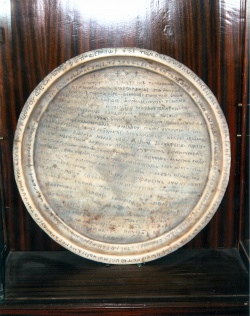WN: Difference between revisions
No edit summary |
No edit summary |
||
| Line 5: | Line 5: | ||
The tray is made from white marble, 72 cm in diameter with a double flat rim carrying a Greek inscription. The floor of the tray measures 59 cm in diameter and carries an inscription in Old Nubian. Both inscriptions on the tray were first fully transcribed in Griffith 1928b, who also proposed a first, tentative translation of portions of the Old Nubian text. | The tray is made from white marble, 72 cm in diameter with a double flat rim carrying a Greek inscription. The floor of the tray measures 59 cm in diameter and carries an inscription in Old Nubian. Both inscriptions on the tray were first fully transcribed in Griffith 1928b, who also proposed a first, tentative translation of portions of the Old Nubian text. | ||
In ''Nubian Voices'', a monograph in the Journal for Juristic Papyrology Supplements series, Vincent van Gerven Oei proposes an improved translation and analysis of this inscription. | In ''Nubian Voices'', a monograph in the Journal for Juristic Papyrology Supplements series, Vincent van Gerven Oei proposes an improved [[Wadi_Natrun_Translation|translation]] and analysis of this inscription. | ||
[[Category:Texts]] | [[Category:Texts]] | ||
[[Category: | [[Category:Inscriptions]] | ||
[[Category:Greek]] | [[Category:Greek]] | ||
[[Category:Old Nubian]] | [[Category:Old Nubian]] | ||
[[Category:Wadi 'n-Natrun]] | [[Category:Wadi 'n-Natrun]] | ||
Latest revision as of 11:55, 4 May 2014

The memorial of King George (commonly referred to as WN) was discovered by H.G. Evelyn White in 1920 during excavations for the Metropolitan Museum of New York in the Monastery of the Syrians (Dēr es-Suriān, officially called ‘The Monastery of the Mother of God of Abba Bishōi’), one of the four monasteries present in the Wādī en-Natrūn, in a secondary church called es-Sitt Miryām (‘The Lady Mary’), resting against the east wall of the southern sanctuary.
The tray is made from white marble, 72 cm in diameter with a double flat rim carrying a Greek inscription. The floor of the tray measures 59 cm in diameter and carries an inscription in Old Nubian. Both inscriptions on the tray were first fully transcribed in Griffith 1928b, who also proposed a first, tentative translation of portions of the Old Nubian text.
In Nubian Voices, a monograph in the Journal for Juristic Papyrology Supplements series, Vincent van Gerven Oei proposes an improved translation and analysis of this inscription.